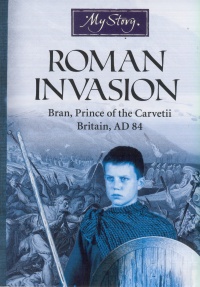| ________________
CM . . .
. Volume XVI Number 40. . . .June 18, 2010
excerpt:
The Romans have taken prisoner Bran, his mother, sister, and three cousins after a failed attack by their tribe on the invading army. As royalty, they have been spared death for “something special.” Bran’s three cousins are sent to Rome to provide entertainment as gladiators. Bran is sent with a legion of soldiers to build a major road. His job is to prevent attacks on the legion as no Briton tribes will risk the death of the Carvetii prince. His mother and sister will remain with the main army to be killed immediately if Bran attempts escape. As part of the “My Story” series, Roman Invasion: Bran, Prince of the Carvetii Britain, AD 84 documents the story of a young person in a notable historical time. Bran’s journey allows him, and the readers, to observe the organization and discipline of the Roman army. This informational component is the strongest part of the novel. The construction of the road, the Roman soldier-training program, and the systematic invasion of Briton are described in great detail. The facts are presented in an interesting style that encourages the reader to ask more questions that are usually answered in later text. The other strength in this book is the description of the human relationships and conflicts. Bran begins the journey with a clear belief as to who is good and who is evil. He has spent his entire life hating and fearing the Romans. Over the course of his story, these beliefs are challenged. Bran is made aware of the similarities between him and many of the Roman soldiers. As he travels with Pentheus and Talos, the road engineer and his nephew, he discovers that many of the “Romans” are conquered people who, when given the choice, became Roman soldiers to avoid death. The Roman army is, in fact, a multicultural mosaic. Bran is forced to put faces to the previous faceless enemy. After a night attack on the legion, the sentry who dozed off for a moment is given the punishment of 100 lashes, a punishment which kills him. Bran becomes the target of revenge for the victim’s brother, and Bran sees the love and loyalty between them. He also witnesses the fear of the army, itself, when two soldiers kill the brother to avoid decimation because of his treason. Bran’s growing relationships with Pentheus and Talos challenge Bran’s understandings of friend and enemy. While the informational component is strong, what is lacking is a true story. There is a subplot dealing with Talos’s muteness that is not developed fully enough to understand its importance. The journey with the road building crew seems somewhat contrived, and many questions remain at the abrupt ending. The author tries to deal with these in an ineffective epilogue that takes place 30 years after the story and doesn’t really provide closure. In the epilogue, Bran says that he had wanted to name his children after Pentheus and Talos, but that wouldn’t have gone over very well, and so he didn’t. Possibly, this is to continue the complexity of the relationships in this time, but it seems an awkward way to frame the importance of the learning that Bran supposedly took away from his journey. There is also no explanation as to why Bran and his mother and sister were allowed to return to their village and continue to battle the Romans. This, too, seems out of character with what we have learned. This ending, while disappointing, doesn’t take away from the engaging style of the rest of the book. Roman Invasion remains an interesting and informative read. Roman Invasion also includes several appendices: an historical note, information on the Roman army, Roman religion, Celtic religion, a timeline, and some pictures. These are useful pieces both for the pleasure reader and those readers who may be including this novel in a larger Roman study. Recommended. Karen Boyd is a graduate student in Language and Literacy at the University of Manitoba and teaches in the Bachelor of Education program.
To comment
on this title or this review, send mail to cm@umanitoba.ca.
Copyright © the Manitoba Library Association. Reproduction for personal
use is permitted only if this copyright notice is maintained. Any
other reproduction is prohibited without permission.
NEXT REVIEW
| TABLE OF CONTENTS FOR THIS ISSUE
- June 18, 2010.
AUTHORS
| TITLES|
MEDIA REVIEWS |
PROFILES |
BACK ISSUES |
SEARCH |
CMARCHIVE |
HOME
|
